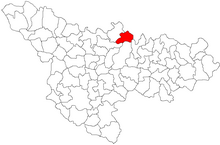Altringen
|
Altringen Altringen Kisrekas |
||||
|
||||
| Basic data | ||||
|---|---|---|---|---|
| State : |
|
|||
| Historical region : | Banat | |||
| Circle : | Timiș | |||
| Municipality : | Bogda | |||
| Coordinates : | 45 ° 59 ' N , 21 ° 33' E | |||
| Time zone : | EET ( UTC +2) | |||
| Height : | 272 m | |||
| Residents : | 27 (2002) | |||
| Postal code : | 307071 | |||
| Telephone code : | (+40) 02 56 | |||
| License plate : | TM | |||
| Structure and administration (as of 2012) | ||||
| Community type : | Village | |||
| Mayor : | Luca Dorel ( USL ) | |||
Altringen ( German Altringen , Altring ; Hungarian Kisrecas ) is a village in Timiș County , Banat , Romania . Altringen belongs to the municipality of Bogda .
Geographical location
Altringen is located in the north of Timiș County, 46 kilometers from Timișoara , halfway between Timișoara and Arad . The village is located on the DJ 691A road and has access to the neighboring Șarlota train station on the Timișoara - Radna railway line . Neighboring places of Altringen are Bogda ( German Neuhof ) in the east, Buzad in the south and Charlottenburg in the west.
| Mașloc | Zăbrani | Chesinț |
| Charlottenburg |

|
Bogda |
| Remetea Mica | Buzad | Cheveșdia |
history
In the Middle Ages, there was a Romanian-Serbian settlement in the area of today's Altringen. The place was first mentioned in documents in 1463 under the name of Rekas as a property of the Hagymas family . In 1499 the village appeared in the documents under the name Kiss Rekas . The name Rokasicza was noted on the Mercy map from 1723 to 1725 . The Romanians called the place Recășel until the First World War . Charlottenburg and Altringen are the only localities in the area that retained their German names after the Treaty of Trianon , when two thirds of the Banat were granted to Romania.
In the years 1771 to 1772 the village was settled by the then governor Johann Altringen with 32 German families mainly from Baden , Württemberg , Bavaria and the Palatinate . For this purpose, the locals were resettled in the surrounding Romanian villages.
On June 4, 1920, the Banat was divided into three parts as a result of the Treaty of Trianon . The largest, eastern part, to which Altringen also belonged, fell to Romania.
As a result of the Waffen-SS Agreement of May 12, 1943 between the Antonescu government and Hitler's Germany , all men of German origin who were conscripted into the German army. Before the end of the war, in January 1945, all ethnic German women between 18 and 30 and men between the ages of 16 and 45 were deported to the Soviet Union for reconstruction work .
The Land Reform Act of March 23, 1945 , which provided for the expropriation of German farmers in Romania, deprived the rural population of their livelihoods. The expropriated land was distributed to smallholders, farm workers and colonists from other parts of the country. The collectivization of agriculture was initiated in the early 1950s . Through the nationalization law of June 11, 1948 , which provided for the nationalization of all industrial and commercial enterprises, banks and insurance companies, the expropriation of all economic enterprises took place regardless of ethnicity.
Demographics
Altringen has always been a German village. At the census of 1880 it had 202 inhabitants, of which 191 were Germans and 11 Romanians . In 1900 Altringen had 217 inhabitants. In 1910 the proportion of Germans was 88 percent. After the Second World War , when the Germans began to emigrate, the total number of residents also decreased. In 2002 there were still 27 people living in Altringen, including 24 Romanians and 3 Hungarians .
tourism
After the revolution of 1989 , more and more Timișoara people started buying a holiday home in Altringen. A pension that bears the name of the village Casa Altringen was also launched. Altringen gradually developed into a tourist destination. The imminent decline of the village could be averted.
See also
- List of German and Hungarian names of Romanian places
- Portal: Romania / List of localities in the Banat
literature
- Elke Hoffmann, Peter-Dietmar Leber and Walter Wolf : The Banat and the Banat Swabians. Volume 5. Cities and Villages , Media Group Universal Grafische Betriebe München GmbH, Munich, 2011, 670 pages, ISBN 3-922979-63-7 .
Web links
- banaterra.eu , Altringen
- casaaltringen.ro , Casa Altringen


